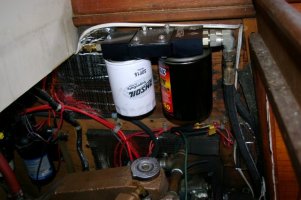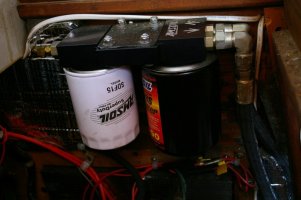Bolo
Contributing Partner
Our boat "Vesper", an Ericson 32-III, has been "winterized" and part of that was changing the oil in our M25XP engine. Now I've done this many times but overtime I do it I guess I marvel at the stupidity of the placement of the "banjo" type fitting on the oil pan. It's located at the forward, starboard corner of the pan and with the engine tilted in the boat away from this point not all the oil can be removed through the hose connected to the banjo fitting. I use a 12 volt oil extractor, which works great, but I insert the hose through dip stick tube down into the pan. Even at that point not all the oil is drained because the tube doesn't go into the pan at the back, lowest point.
So, my question is, does anyone make an oil pan for a M25XP the has a drain plug located at or near the low end (back end) of the pan. Seems to me that it would make more sense. I've even thought of taking the pan off, some how installing another drain point at the back of the pan where I would relocate the banjo fitting. Unless, of course, someone already makes one. Also, how hard would it be to replace the pan and gasket? I imagine that the engine would have to be lifted a bit for clearance.
So, my question is, does anyone make an oil pan for a M25XP the has a drain plug located at or near the low end (back end) of the pan. Seems to me that it would make more sense. I've even thought of taking the pan off, some how installing another drain point at the back of the pan where I would relocate the banjo fitting. Unless, of course, someone already makes one. Also, how hard would it be to replace the pan and gasket? I imagine that the engine would have to be lifted a bit for clearance.

 I didn't expect it to get into the make up of the "old" oil left in the pan but it was still interesting reading. To be honest, I agree that the little bit of un-reachable oil left in the pan after I use my oil suction pump via the dip stick, isn't such a big deal. Still would like to know how had it would be to change the oil pan seal. Would I have to lift the engine?
I didn't expect it to get into the make up of the "old" oil left in the pan but it was still interesting reading. To be honest, I agree that the little bit of un-reachable oil left in the pan after I use my oil suction pump via the dip stick, isn't such a big deal. Still would like to know how had it would be to change the oil pan seal. Would I have to lift the engine?
